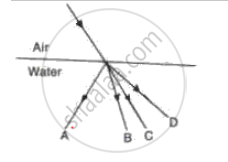Advertisements
Advertisements
प्रश्न
Four students A, B, C and D traced the paths of incident ray and the emergent ray by fixing pins P and Q for incident ray and pins R and S for emergent ray for a ray of light passing through a glass slab.

The correct emergent ray was traced by the student:
(1) A
(2) B
(3) C
(4) D
उत्तर
(2) B
APPEARS IN
संबंधित प्रश्न
How is the angle of emergence related to the angle of incidence when prism is in the position of minimum deviation? Illustrate your answer with help of a labelled diagram using an equilateral prism?
Name the colour of white light which is deviated the most on passing through a prism.
A Water pond appears to be 2.7 m deep. If the refractive index of water is 4/3, find the actual depth of the pond.
-
- the angle of refraction and
- the angle of deviation for the ray?
A ray of light passes from air to water. In fig. 39, which of the ray A, B, C and D is the correct refracted ray?

Draw a ray diagram showing the lateral displacement of a ray of light when it passes through a parallel sided glass slab.
Which colour of light travels fastest in any medium except air?
Define the term refractive index of a medium in terms of velocity of light.
A ray of monochromatic light is incident from the air on a glass slab:
(i) Draw a labelled ray diagram showing the change in the path of the ray till it emerges from the glass slab.
(ii) Name the two rays that are parallel to each other.
(iii) Mark the lateral displacement in your diagram.
The diagram below shows two parallel rays A (Orange) & B (Blue) incident from air, on air-glass boundary.

- Copy and complete the path of the rays A and B.
- How do the speeds of these rays differ in glass?
- Are the two refracted rays in glass parallel? Give a reason.
